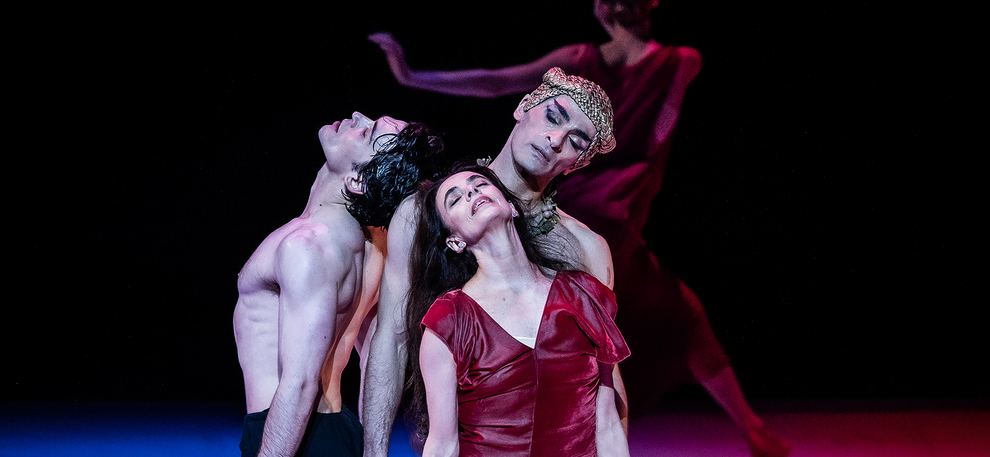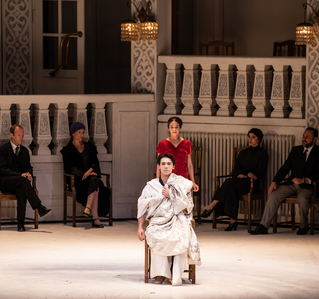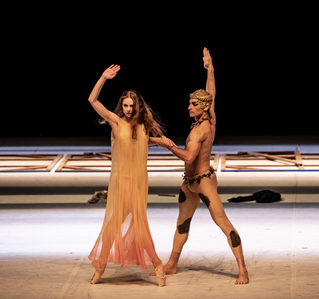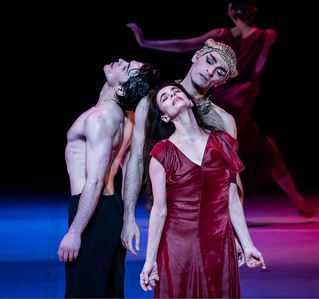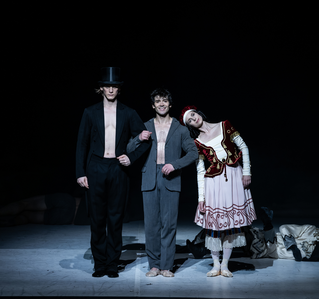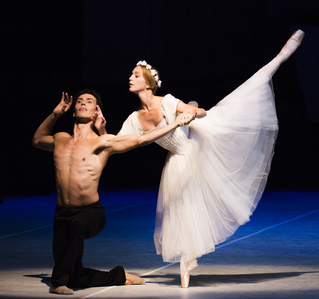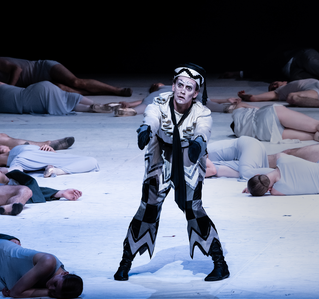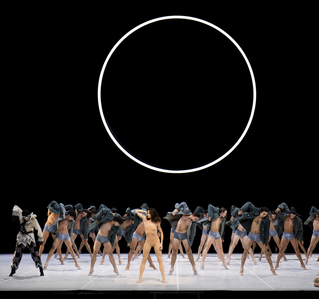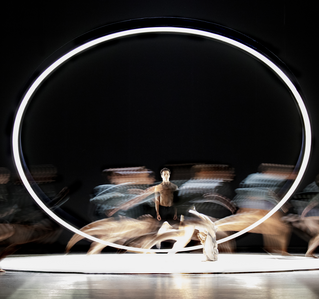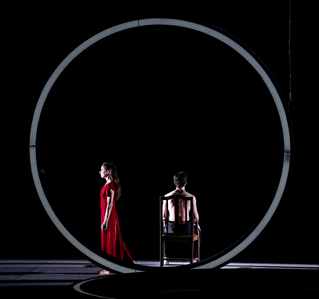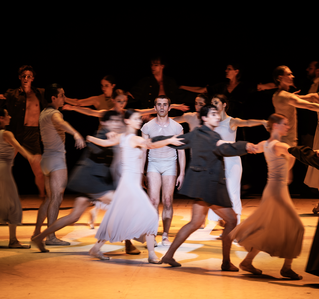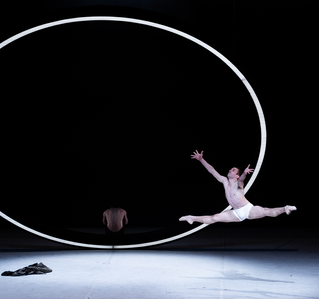Fr 03.10.2025, 20.00 - 22.30 Uhr | Gastspiel in Baden-Baden, Festspielhaus
Ballett von John Neumeier
Nijinsky
"Nijinskys Leben lässt sich einfach zusammenfassen: zehn Jahre Wachsen, zehn Jahre Lernen, zehn Jahre Tanzen, dreißig Jahre Finsternis", formulierte einst der Biograf Richard Buckle. Vaslav Nijinsky, der als "Gott des Tanzes" verehrt wurde, hinterließ nicht nur mit seinen atemberaubenden Sprüngen und seinem charismatischen Auftreten einen bleibenden Eindruck. Seine choreografische Arbeit wies den Weg zum modernen Tanz. Das Phänomen Nijinsky hat John Neumeier seit seiner Jugend bewegt. Sein 2000 uraufgeführtes Ballett "Nijinsky" zeigt ein Leben in Extremen: Nijinsky im Glanz der Scheinwerfer als Star der Ballet Russes, jener weltberühmten Compagnie unter der Ägide von Serge Diaghilew, ebenso wie im Wahnsinn, im Schatten seiner Zweifel und Ängste. John Neumeier beschwört einige der größten Rollen dieses einzigartigen Künstlers herauf, wie etwa den Goldenen Sklaven, Petruschka oder den Faun. Im Kontrast dazu steht der zweite Teil, der sich mit Nijinskys inneren Kämpfen auseinandersetzt. Unter dem eindringlichen Einfluss von Dmitri Schostakowitschs 11. Sinfonie entfalten sich düstere Visionen des Ersten Weltkriegs und die Herausforderungen, die Nijinsky letztlich in die Psychiatrie führten. John Neumeier schafft eine fesselnde Hommage an Vaslav Nijinsky, dessen Genie untrennbar mit seinen Dämonen verbunden ist.
Musik: Frédéric Chopin, Nikolaj Rimskij-Korsakow, Dmitri Schostakowitsch, Robert Schumann
Choreografie, Bühnenbild und Kostüme: John Neumeier
unter teilweiser Verwendung der Originalentwürfe von Léon Bakst und Alexandre Benois
2 Stunden 30 Minuten | 1 Pause
1. Teil: 65 Minuten, 2. Teil: 60 Minuten
URAUFFÜHRUNG:
Hamburg Ballett, Hamburg, 2. Juli 2000
ORIGINALBESETZUNG:
Vaslaw Nijinsky: Jirí Bubenícek
Romola Nijinsky: Anna Polikarpova
Bronislava Nijinska: Elizabeth Loscavio
Stanislaw Nijinsky: Yukichi Hattori
Serge Diaghilew: Ivan Urban
Eleonora Bereda: Joëlle Boulogne
Thomas Nijinsky: Carsten Jung
Die Ballerina, Tamara Karsavina: Heather Jurgensen
Der neue Tänzer, Leonid Massine: Guido Warsany
Der Tänzer Nijinsky: als Harlequin in "Carnaval": Alexandre Riabko
als Geist der Rose in "Spectre de la rose": Alexandre Riabko
als Goldener Sklave in "Scheherazade": Otto Bubenícek
als junger Mann in "Jeux": Guido Warsany
als Faun in "L'Après-midi d'un faune": Otto Bubenícek
als Petruschka in "Petruschka": Lloyd Riggins
GASTSPIELE:
2001 Hannover 2002 Kopenhagen, Baden-Baden 2003 Hongkong, Madrid, Paris, St. Petersburg 2004 New York, Orange County (CA), Reggio Emilia, Washington 2005 Tokio 2009 Monte-Carlo 2011 Stuttgart 2012 Beijing, Shanghai, Brisbaine 2013 Chicago, San Francisco 2017 Baden-Baden 2018 Tokio 2020 Macau 2025 Baden-Baden
IM REPERTOIRE:
Semperoper Ballett
The Australian Ballet
The National Ballet of Canada
Altersempfehlung: ab 14 Jahren / Klasse 9
Am 19. Januar 1919 um fünf Uhr nachmittags tanzte Vaslaw Nijinsky im Ballsaal des Suvretta House in St. Moritz zum letzten Male öffentlich. Er nannte seine Vorstellung "Hochzeit mit Gott". Mein Ballett "Nijinsky" beginnt mit einer realistischen Wiedergabe dieser Szene. Die folgende Choreografie visualisiert Nijinskys Gedanken, Erinnerungen und Wahnvorstellungen während seines letzten Auftrittes.
TEIL I
Hervorgerufen durch das Trugbild seines ehemaligen Mentors, Impresarios und Liebhabers Serge Diaghilew ruft sich Nijinsky Bilder seiner sensationellen Karriere mit den Ballets Russes ins Gedächtnis zurück. Tänzer, als Teile seiner Persönlichkeit, führen Fragmente seiner herausragenden Rollen auf. Harlequin, der Dichter aus "Les Sylphides", der Goldene Sklave aus "Scheherazade" und der Geist der Rose vermengen sich mit Charakteren aus seinem eigenen Leben. Seine Schwester Bronislawa, die spätere Choreografin, sein älterer Bruder Stanislaw – der ebenfalls zu einem Tänzer ausgebildet wurde und von Kindheit an mit Anflügen von Wahnsinn versehen war – und die Mutter Eleonora Bereda, die gemeinsam mit dem Vater die frühesten Lehrer ihrer Kinder waren, erscheinen in seiner traumdurchwebten Fantasie.
In einer anderen Szene meines Balletts erinnert sich Nijinsky an sein kompromissloses Ringen um eine neue choreografische Sprache. Seine Bewegungsexperimente fließen ein in die Ballette "L'Après-midi d'un faune", "Jeux", "Le Sacre du printemps" und später "Till Eulenspiegel".
Eine Frau in Rot, Romola de Pulsky, Nijinskys spätere Frau, durchkreuzt seine verworrenen Erinnerungen. Noch einmal erlebt er ihre erste Begegnung während einer Schifffahrt nach Südamerika und ihre plötzliche Vermählung – ein Ereignis, das den endgültigen Bruch mit Diaghilew und den Ballets Russes hervorrief.
TEIL II
Nijinskys Wahnsinn führt ihn tiefer in sein inneres Wesen. Erinnerungen an Kindheit, Familie, Schule und Mariinsky-Theater vermischen sich mit alptraumhaften Visionen des Ersten Weltkrieges – und der Untreue seiner Frau.
Die skandalträchtige Premiere seines Ballettes "Le Sacre du printemps" wird der Brutalität des Ersten Weltkrieges und dem Tod seines Bruders Stanislaw gegenübergestellt. Romola begleitet ihn durch schwierige und schlechte Zeiten.
In Nijinskys Augen ist es die Welt, die ihn umgibt – nicht Nijinsky, der geisteskrank wird...
Die Vorstellung im Suvretta House und mein Ballett enden mit Nijinskys letztem Tanz – dem Krieg.
John Neumeier, Hamburg 2000
VERWENDETE MUSIK
FRÉDÉRIC CHOPIN
Prélude Nr. 20
ROBERT SCHUMANN
"Faschingsschwank aus Wien", op. 26, 1. Fantasiebild
NIKOLAJ RIMSKIJ-KORSAKOW
"Scheherazade", op. 35, 1., 3. und 4. Satz
DMITRI SCHOSTAKOWITSCH
Sonate für Viola und Klavier, op. 147, 3. Satz
Sinfonie Nr. 11 g-moll, "Das Jahr 1905", op. 103
Das Programmheft (derzeit nicht lieferbar) und die DVD sind in unserem Onlineshop erhältlich

